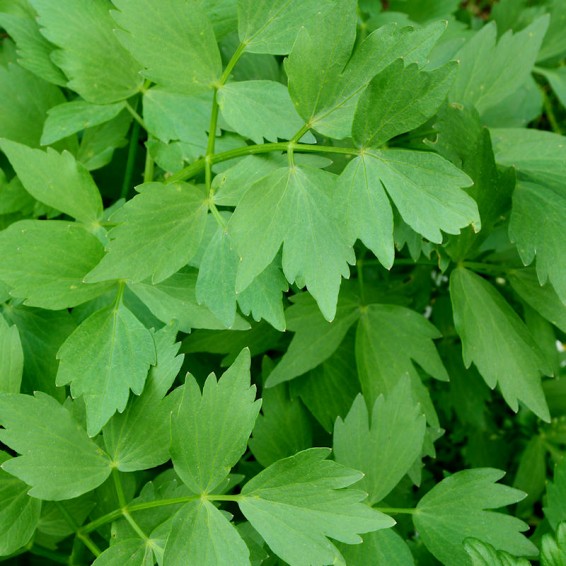Organic Lovage Seeds
Levisticum officinale
- HOW TO GROW
- FAST FACTS
HOW TO GROW
Sowing: To start lovage indoors, plant the seeds 1/4" deep in a flat 6-8 weeks before the last spring frost. Germination usually occurs within 10-14 days, but can be longer. Keep the soil lightly moist with a spray bottle or careful watering, and keep the temperature cool for best results. When the seedlings are big enough to handle and there is no chance of frost, plant them 2-3' apart in rich soil and full sun or partial shade. To direct sow, plant 3-4 seeds in groups 2-3' apart and thin to the strongest seedling. Lovage can also be direct sown in the fall for early spring growth.
Growing: Lovage thrives in moist soil, and needs regular watering especially when it is becoming established. Control weeds. A very hardy herb, lovage survives cold well but will need mulching in very cold winters. Since lovage easily reseeds itself, cut the flowering heads before they go to seed to prevent volunteer plants. Cutting back the stems will cause the growth of new and more abundant leaves. After several years of growth, lovage benefits from being dug up and divided; the plant grows well from root and stem cuttings, and parts of the extensive roots can then be harvested for culinary use.
Harvesting: As soon as the plant reaches a height of 12", harvesting can begin. Harvest fresh leaves or stems as needed, taking the outer stems first; the best time to harvest is in the morning after the dew has dried. Though fresh leaves and stems have the best flavor, they can also frozen; drying tends to deprive them of flavor. The roots, which are also edible, can be harvested in the spring or fall after the plant has been established and needs to be divided. Wash the roots, cut them into 1/2" pieces, and spread them out to dry for several weeks. The seeds, which are similar in flavor to celery seed, can be harvested as soon as the seed heads begin to dry and develop mature seed. Store the seed in an airtight container.
Seed Saving: Allow the flowering seed heads to dry and develop mature seed; remove them and spread them out to dry away from direct sunlight. Thresh them to remove the seed. Store the seed in a cool, dry place. For best germination, use the seed as soon as possible.
FAST FACTS
Latin Name: Levisticum officinale
Species Origin: Mediterranean, Europe, Southwest Asia
Type: Open Pollinated, Heirloom, Cool Season
Life Cycle: Perennial
USDA Zones: 4, 5, 6, 7, 8, 9, 10, 11, 12
Seeds per Ounce: 10,000
Planting Method: From Transplant
Planting Depth: 0.1
Planting Spacing: 20
Days to Maturity: 90
Sunlight: Full Sun, Part Sun
Height: 60 Inches
Color: White, Cream
Bloom Season: Blooms Early Summer, Blooms Late Summer
Uses: Aromatic
Pests: Celery Worm, Leaf Miner
Diseases: Early Blight, Late Blight, Leaf Spot
DESCRIPTION
HOW TO GROW
Sowing: To start lovage indoors, plant the seeds 1/4" deep in a flat 6-8 weeks before the last spring frost. Germination usually occurs within 10-14 days, but can be longer. Keep the soil lightly moist with a spray bottle or careful watering, and keep the temperature cool for best results. When the seedlings are big enough to handle and there is no chance of frost, plant them 2-3' apart in rich soil and full sun or partial shade. To direct sow, plant 3-4 seeds in groups 2-3' apart and thin to the strongest seedling. Lovage can also be direct sown in the fall for early spring growth.
Growing: Lovage thrives in moist soil, and needs regular watering especially when it is becoming established. Control weeds. A very hardy herb, lovage survives cold well but will need mulching in very cold winters. Since lovage easily reseeds itself, cut the flowering heads before they go to seed to prevent volunteer plants. Cutting back the stems will cause the growth of new and more abundant leaves. After several years of growth, lovage benefits from being dug up and divided; the plant grows well from root and stem cuttings, and parts of the extensive roots can then be harvested for culinary use.
Harvesting: As soon as the plant reaches a height of 12", harvesting can begin. Harvest fresh leaves or stems as needed, taking the outer stems first; the best time to harvest is in the morning after the dew has dried. Though fresh leaves and stems have the best flavor, they can also frozen; drying tends to deprive them of flavor. The roots, which are also edible, can be harvested in the spring or fall after the plant has been established and needs to be divided. Wash the roots, cut them into 1/2" pieces, and spread them out to dry for several weeks. The seeds, which are similar in flavor to celery seed, can be harvested as soon as the seed heads begin to dry and develop mature seed. Store the seed in an airtight container.
Seed Saving: Allow the flowering seed heads to dry and develop mature seed; remove them and spread them out to dry away from direct sunlight. Thresh them to remove the seed. Store the seed in a cool, dry place. For best germination, use the seed as soon as possible.
FAST FACTS
Latin Name: Levisticum officinale
Species Origin: Mediterranean, Europe, Southwest Asia
Type: Open Pollinated, Heirloom, Cool Season
Life Cycle: Perennial
USDA Zones: 4, 5, 6, 7, 8, 9, 10, 11, 12
Seeds per Ounce: 10,000
Planting Method: From Transplant
Planting Depth: 0.1
Planting Spacing: 20
Days to Maturity: 90
Sunlight: Full Sun, Part Sun
Height: 60 Inches
Color: White, Cream
Bloom Season: Blooms Early Summer, Blooms Late Summer
Uses: Aromatic
Pests: Celery Worm, Leaf Miner
Diseases: Early Blight, Late Blight, Leaf Spot





